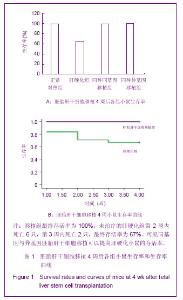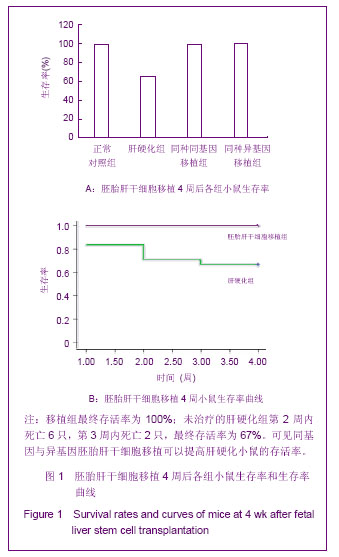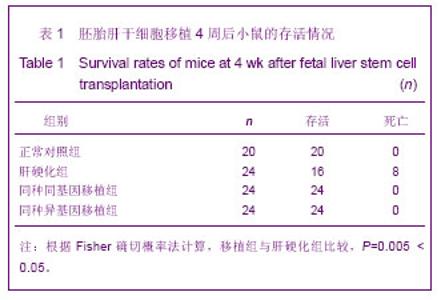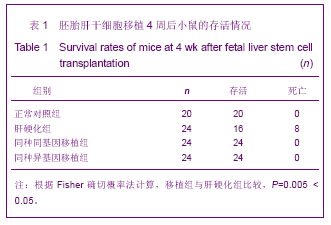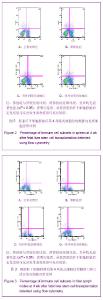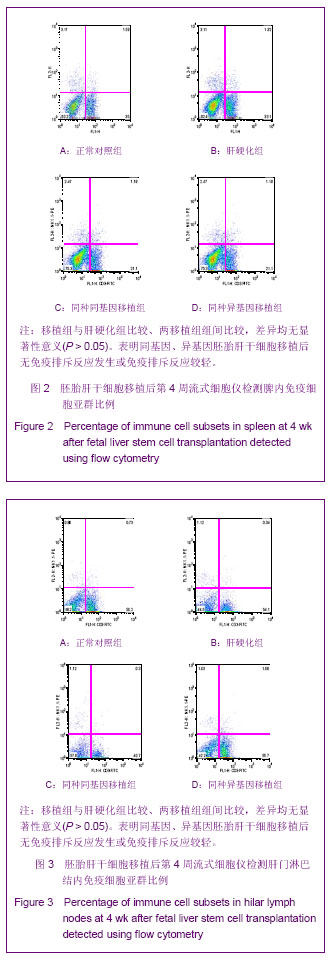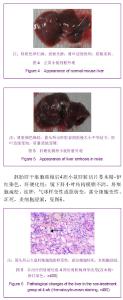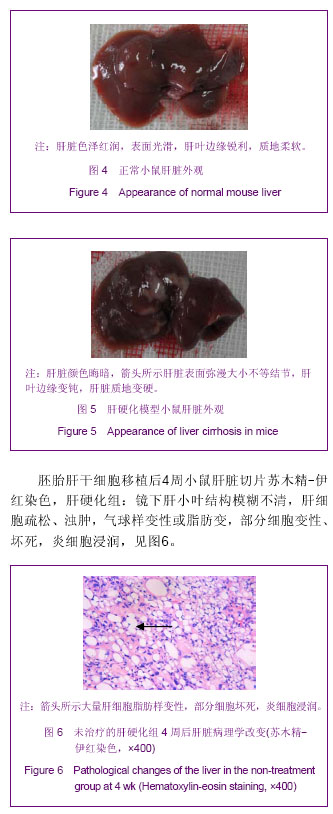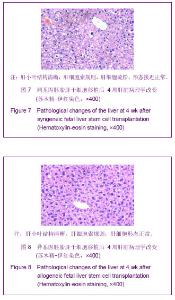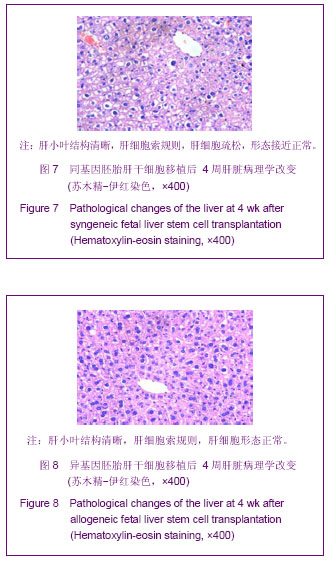Chinese Journal of Tissue Engineering Research ›› 2013, Vol. 17 ›› Issue (36): 6474-6480.doi: 10.3969/j.issn.2095-4344.2013.36.015
Previous Articles Next Articles
Syngeneic and allogeneic fetal liver stem cell transplantation in the treatment of mouse hepatic cirrhosis
Han Bo1, Xu San-rong2, Zhang Jin2, Zhou Qing2, Li Wei1
- 1Clinical College of Jiangsu University, Zhenjiang 212001, Jiangsu Province, China; 2Affiliated Hospital of Jiangsu Province, Zhenjiang 21200
-
Online:2013-09-03Published:2013-09-03 -
Contact:Xu San-rong, M.D., Chief physician, Affiliated Hospital of Jiangsu Province, Zhenjiang 212001, Jiangsu Province, China -
About author:Han Bo★, Master, Attending physician, Clinical College of Jiangsu University, Zhenjiang 212001, Jiangsu Province, China 393872056@qq.com -
Supported by:the General Program of Science Foundation of Zhenjiang City, No. SH2011023*
CLC Number:
Cite this article
Han Bo, Xu San-rong, Zhang Jin, Zhou Qing, Li Wei . Syngeneic and allogeneic fetal liver stem cell transplantation in the treatment of mouse hepatic cirrhosis[J]. Chinese Journal of Tissue Engineering Research, 2013, 17(36): 6474-6480.
share this article
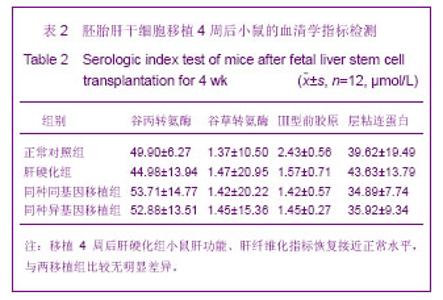
2.2 小鼠一般生存情况 肝硬化造模16周时小鼠精神萎靡,反应迟钝,食欲差,活动减少,毛发蓬乱,尿色深黄,体质差。移植7 d后,肝硬化组:精神差,反应迟钝,饮食活动渐增加,毛发乱,尿色黄,体质差;两移植组精神稍差,反应稍迟钝,饮食活动渐增加,毛发稍乱,尿色浅黄,体质差。4周后各组均正常饮食,活动自如,毛发正常,尿色浅黄,体质量增加。 2.3 小鼠肝功能及肝纤维化指标检测 肝硬化造模16周后小鼠血清谷丙转氨酶和谷草转氨酶等肝功能指标和肝纤维化指标升高。胚胎肝干细胞移植后3,7 d移植组肝功能指标谷丙转氨酶和谷草转氨酶等明显降低,同种异基因移植组优于同种同基因移植组(P < 0.05)。移植后4周,两移植组与肝硬化组相比,差异无显著性意义(P > 0.05),肝功能及肝纤维化指标见表2。"
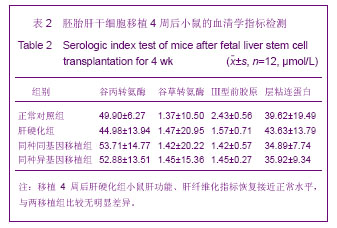
| [1] Schuppan D, Afdhal NH. Liver cirrhosis. Lancet. 2008;371 (9615): 838-851..
[2] 严律南.活体肝移植的现状与展望[J].中国普外基础与临床杂志, 2007,14(2):128-131.
[3] 余希,施明,刘振文,等.肝移植免疫排斥与免疫耐受机制研究进展[J].细胞与分子免疫学杂志, 2012, 28(7): 761-763.
[4] 朱继业,王东.肝移植术后急性排斥反应[J].中华肝脏病杂志, 2005, 13(3): 223-224.
[5] Hughes RD, Mitry RR, Dhawan A. Current status of hepatocyte transplantation. Transplantation. 2012;93(4):342-347.
[6] Ito M, Nagata H, Miyakawa S,et al. Review of hepatocyte transplantation.J Hepatobiliary Pancreat Surg. 2009;16(2): 97-100.
[7] Puppi J, Dhawan A. Human hepatocyte transplantation overview. Methods Mol Biol. 2009;481:1-16.
[8] 赵中辛,丁友成.异种肝细胞移植排斥机理的探讨[J].中华器官移植杂志,2001,22(5): 280-281.
[9] 林丛,侯宽永,张文秀,等.深低温在肝细胞移植中减轻免疫排斥反应的作用[J].北京医科大学学报, 1998,30(1): 32-34.
[10] Evans MJ, Kaufman MH. Establishment in culture of pluripotential cells from mouse embryos. Nature. 1981;292 (5819):154-156.
[11] Yamada T, Yoshikawa M, Kanda S,et al. In vitro differentiation of embryonic stem cells into hepatocyte-like cells identified by cellular uptake of indocyanine green. Stem Cells. 2002;20(2): 146-154.
[12] Oikawa T, Kamiya A, Kakinuma S,et al. Sall4 regulates cell fate decision in fetal hepatic stem/progenitor cells. Gastroenterology. 2009;136(3):1000-1011.
[13] Tsuchiya A, Heike T, Baba S,et al. Long-term culture of postnatal mouse hepatic stem/progenitor cells and their relative developmental hierarchy. Stem Cells. 2007; 25(4): 895-902.
[14] Chinzei R, Tanaka Y, Shimizu-Saito K,et al. Embryoid-body cells derived from a mouse embryonic stem cell line show differentiation into functional hepatocytes. Hepatology. 2002; 36(1):22-29.
[15] Yin Y, Lim YK, Salto-Tellez M,et al. AFP(+), ESC-derived cells engraft and differentiate into hepatocytes in vivo.Stem Cells. 2002;20(4):338-346.
[16] Sandhu JS, Petkov PM, Dabeva MD,et al. Stem cell properties and repopulation of the rat liver by fetal liver epithelial progenitor cells. Am J Pathol. 2001;159(4): 1323-1334.
[17] Ochsner SA, Strick-Marchand H, Qiu Q,et al.Transcriptional profiling of bipotential embryonic liver cells to identify liver progenitor cell surface markers.Stem Cells. 2007;25(10): 2476-2487.
[18] Tanimizu N, Nishikawa M, Saito H,et al. Isolation of hepatoblasts based on the expression of Dlk/Pref-1.J Cell Sci. 2003;116(Pt 9):1775-1786.
[19] Kakinuma S, Ohta H, Kamiya A,et al. Analyses of cell surface molecules on hepatic stem/progenitor cells in mouse fetal liver.J Hepatol. 2009;51(1):127-138.
[20] 陆再英,钟南山.内科学[M].7版.北京:人民卫生出版社,2008: 445-455.
[21] Suzuki A, Nakauchi H, Taniguchi H. In vitro production of functionally mature hepatocytes from prospectively isolated hepatic stem cells. Cell Transplant. 2003;12(5):469-473.
[22] Bae SH. Clinical application of stem cells in liver diseases.Korean J Hepatol. 2008;14(3):309-317.
[23] Zhang B, Inagaki M, Jiang B,et al. Effects of bone marrow and hepatocyte transplantation on liver injury.J Surg Res. 2009; 157(1): 71-80.
[24] Bin WT, Ma LM, Xu Q,et al. Embryonic hepatocyte transplantation for hepatic cirrhosis: efficacy and mechanism of action.World J Gastroenterol. 2012;18(4):309-322.
[25] 申定珠,陶庆,胡义扬,等.四氯化碳肝纤维化大鼠肝组织差异蛋白质组的动态变化[J]. 中华肝脏病杂志, 2012, 20(9): 664-670.
[26] 张磊,李俊,朱鹏里,等.四氯化碳诱导大鼠肝纤维化进展期和恢复期模型的建立[J].中国药理学通报, 2011, 27(12): 1757-1760.
[27] 叶霖财,肖智勇,周文霞,等.四氯化碳致肝纤维化动物模型实验条件的优化[J].军事医学科学院院刊, 2010, 34(4):340-344.
[28] Nowak G, Ericzon BG, Nava S,et al. Identification of expandable human hepatic progenitors which differentiate into mature hepatic cells in vivo.Gut. 2005;54(7):972-979.
[29] Machimoto T, Yasuchika K, Komori J,et al. Improvement of the survival rate by fetal liver cell transplantation in a mice lethal liver failure model.Transplantation. 2007;84(10): 1233-1239.
[30] Paku S, Nagy P, Kopper L,et al. 2-acetylaminofluorene dose-dependent differentiation of rat oval cells into hepatocytes: confocal and electron microscopic studies. Hepatology. 2004;39(5):1353-1361.
[31] 吴昌雄,郑进方,梁力建.胚胎肝干细胞癌变实验[J].中国组织工程研究与临床康复, 2009,13(36):7119-7125.
[32] Zimmerer JM, Pham TA, Sanders VM,et al. CD8+ T cells negatively regulate IL-4-dependent, IgG1-dominant posttransplant alloantibody production.J Immunol. 2010; 185(12):7285-7292.
[33] Donckier V, Craciun L, Lucidi V,et al. Acute liver transplant rejection upon immunosuppression withdrawal in a tolerance induction trial: potential role of IFN-gamma-secreting CD8+ T cells.Transplantation. 2009;87(9 Suppl):S91-95.
[34] Tellides G, Pober JS. Interferon-gamma axis in graft arteriosclerosis. Circ Res. 2007;100(5):622-632.
[35] Jiang X, Kojo S, Harada M,et al. Mechanism of NKT cell-mediated transplant tolerance.Am J Transplant. 2007; 7(6):1482-1490.
[36] Rao MS, Khan AA, Parveen N,et al.Characterization of hepatic progenitors from human fetal liver during second trimester.World J Gastroenterol. 2008;14(37):5730-5737.
[37] Kubota H, Reid LM. Clonogenic hepatoblasts, common precursors for hepatocytic and biliary lineages, are lacking classical major histocompatibility complex class I antigen. Proc Natl Acad Sci U S A. 2000;97(22):12132-12137.
[38] Enns GM, Millan MT.Cell-based therapies for metabolic liver disease. Mol Genet Metab. 2008;95(1-2):3-10.
[39] Muraca M, Gerunda G, Neri D,et al. Hepatocyte transplantation as a treatment for glycogen storage disease type 1a.Lancet. 2002;359(9303):317-318.
[40] Cai J, Zhao Y, Liu Y,et al.Directed differentiation of human embryonic stem cells into functional hepatic cells.Hepatology. 2007;45(5):1229-1239.
[41] Duan Y, Catana A, Meng Y,et al. Differentiation and enrichment of hepatocyte-like cells from human embryonic stem cells in vitro and in vivo.Stem Cells. 2007;25(12):3058- 3068. |
| [1] | Wang Jian-ji, Yang Long, Li Jing, Sun Qi, Zuo Wei-min, Ren Qi-feng, Sun Yu, Wu Zhan-yu, Zou Qiang, Ma Min-xian, Ye Chuan. Development and application of special-purpose grafter by femoral head decompression combined with bone marrow mesenchymal stem cells transplantation based on three-dimensional printing technology [J]. Chinese Journal of Tissue Engineering Research, 2016, 20(44): 6636-6642. |
| [2] | Zhou Chang-yan, Zhou Qing-huan, Bian Jing, Chen Ke, Chen Wen. Bone marrow mesenchymal stem cells combined with calcium phosphate cement to repair articular cartilage defects in rabbits [J]. Chinese Journal of Tissue Engineering Research, 2015, 19(8): 1195-1199. |
| [3] | Xu Xiang, Yin He-ping. Platelet-rich plasma accelerates the proliferation of bone marrow mesenchymal stem cells [J]. Chinese Journal of Tissue Engineering Research, 2015, 19(14): 2144-2148. |
| [4] | Ma Fa-ku, Wang Huan, Liu Bin, Yang Yan-li, Su Qin-jun, Qian Zhen, Dong Liang. Expression of CD44+/C-myc+ cancer stem cells and its relationship with the prognosis of patients in colorectal tumors [J]. Chinese Journal of Tissue Engineering Research, 2015, 19(14): 2161-2166. |
| [5] |
Chen Ping, Wang Jian.
Enrichment of lung cancer stem cells and expression of related markers
[J]. Chinese Journal of Tissue Engineering Research, 2015, 19(14): 2167-2171.
|
| [6] | Fan Zhi-gang, Fan Hong-liang. Oxidative stress response in diabetic nephropathy rats following injection of embryonic stem cells via the tail vein [J]. Chinese Journal of Tissue Engineering Research, 2015, 19(14): 2199-2204. |
| [7] | Wang Yong, Zhao Wei, Feng Jian-zhou, Chen Xiao-chun. Nerve growth factor-modified adipose derived stem cells for repair of spinal cord injury [J]. Chinese Journal of Tissue Engineering Research, 2015, 19(14): 2224-2229. |
| [8] | Sha Wen-qiong, She Rui-lian, Wang Zi-neng, Ke Ru. Ultrastructure and phagocytotic function of human placental mesenchymal stem cells [J]. Chinese Journal of Tissue Engineering Research, 2015, 19(14): 2230-2235. |
| [9] | Du Qing-hua, Cao Jun-kai, Dong Xi-xi, E Ling-ling, Wei Li-jun. Osteogenic differentiation of pluripotent stem cells induced by akermanite extracts [J]. Chinese Journal of Tissue Engineering Research, 2015, 19(14): 2236-2242. |
| [10] | Wu Yan, Huang Lan . Bone morphogenetic protein 9-induced osteogenic differentiation of dental follicle cells in vitro [J]. Chinese Journal of Tissue Engineering Research, 2015, 19(14): 2255-2260. |
| [11] | Rao Li-jia, Li Qi-meng, Li Jin-ling, Xu Qiong. Expression pattern of ten-eleven translocation family during differentiation of human dental pulp cells [J]. Chinese Journal of Tissue Engineering Research, 2015, 19(14): 2261-2266. |
| [12] | Gao Zhuo-yue, Liu Yong-qi, He Jian-xin, Wu Zhi-wei, Luo Ya-li, Su Yun, Zhang Li-ying, Zhang Qi, Wu You-ming, Zhou Ni-na. Regulatory effects of warming yang and invigorating qi treatment on the inflammatory balance and genetic stability of bone marrow mesenchymal stem cells under tumor microenvironment [J]. Chinese Journal of Tissue Engineering Research, 2015, 19(14): 2267-2272. |
| [13] | Wang Fang, Chen Shao-wei. In vitro culture of embryos and establishment of embryonic stem cell lines [J]. Chinese Journal of Tissue Engineering Research, 2015, 19(14): 2273-2277. |
| [14] |
Du Wei-bin, Quan Ren-fu, Zheng Xuan, Wang Tuo.
Hair follicle stem cells promote the healing of skin wound
|
| [15] | Du Hua, Shi Ying-xu . Bone marrow microenvironment controls the “fate” of hematopoietic stem cells [J]. Chinese Journal of Tissue Engineering Research, 2015, 19(14): 2283-2290. |
| Viewed | ||||||
|
Full text |
|
|||||
|
Abstract |
|
|||||
